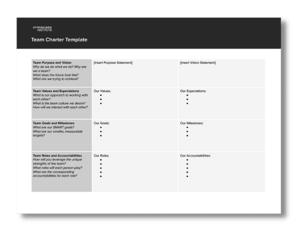6 min read
Defining Team Roles and Responsibilities (+Template)
Would your team members say, “I know what is expected of me at work”? Gallup has spent the last thirty years researching this topic by evaluating...
4 min read
 Michelle Bennett
:
Sep 14, 2023 5:00:00 AM
Michelle Bennett
:
Sep 14, 2023 5:00:00 AM
.png)
Having a great team is essential for achieving outstanding results. While individual talent and expertise play a crucial role, harnessing the collective power of a team requires a shared purpose, clarity on what you’re trying to accomplish, and a mutual responsibility to achieve a common goal. That's where a team charter comes into play.
In this blog, we'll delve into team charters, exploring what they are, why they’re important, and how to create a charter for your own team. We'll also provide you with a team charter template so that you can collaborate with your team to create a foundational document that provides clarity and collective ownership for the team’s success.
Jump to:
A team charter is a guiding document that outlines a team's purpose, goals, roles, responsibilities, and expectations for its operation. It’s foundational to a team’s success as it establishes a shared understanding across a team to enhance clarity, focus, collaboration, and accountability.
Creating a team charter is important as it is a valuable reference that team members use to make decisions, stay aligned, and focus on achieving the team’s objective. It’s an agreement created by team members that clearly defines what they’re trying to accomplish and the expectations and accountabilities for everyone involved to get them there.

Whether leading a newly formed team or looking to revamp an existing one, having a well-crafted team charter can be the key to capitalizing on your team's true potential. You’ll want to have it robust enough that it covers the key factors but is condensed into a single-page document for easy reference.
Creating a team charter should be a collaborative process involving all team members in its conception. When individuals are involved, they’re more likely to remain committed to what they help establish versus when the leader forms a team charter without their input.
When writing a team charter, these four critical areas need to be addressed:
Establishing a clear team vision and purpose is vital for success. Think of it as your team’s north star, which provides a shared sense of direction and motivation. However, to be powerful, it needs to be clear, short, and realistic and address these points below.
When you clearly define team values and expectations, how individuals behave and show up isn’t left to chance. Team values and expectations form the foundation of a positive team culture, as it is abundantly clear what is expected and what won’t be tolerated. Furthermore, because the team has created the values and expectations, they will be more likely to demonstrate positive behaviors and correct their teammates when they fall short of expectations.
Team Values
Your team values are principles that guide your team’s actions and behaviors and will be the foundation from which your team’s culture will form. These values serve as a framework for how team members interact with each other, approach their work, and engage with the larger organization and stakeholders. It is a compass that influences team members' priorities, behaviors, and attitudes. To help get you started, here are a few examples of common team values:
If you’re looking for ideas to create your team values, check out the 110 words to describe company culture, which can help prompt conversations on what your team truly values.
Team Expectations
To establish team expectations, take your team values and put them into concrete behaviors. Team expectations are clear standards that define what is required from each team member to create the right environment where high performance can thrive. Here are a few examples of team expectations to help you get started:
Team goals and milestones are where you bring your vision and purpose to reality by creating concrete targets and timelines for team achievement. Your team goals should follow the SMART goals framework to help focus the team’s efforts and increase the likelihood of achieving goals.
You will want to break goals down into milestones, which are smaller, measurable targets that are checkpoints along the way to achieving the larger goal. These milestones will help the team track progress, provide small wins and motivation, and allow for reflection and adjustments. Each milestone needs to be specific on the outcome, deliverables, and timeline for achievement. And don’t forget to celebrate each milestone as they’re achieved!
The last section is to outline each individual’s role on the team and their personal commitment to owning their specific accountabilities. Use this time to discuss each person’s strengths and how their roles are interdependent and reliant on each other. It’s also an ideal time to discuss the consequences to the team when someone falls short on their accountabilities and how they will support each other so that does not happen.
 Ready to create a team charter of your own? Our free Team Charter Template is thoughtfully crafted to help you simplify and speed up the process of creating a charter for your own team. You’ll find a structured framework and prompts to help you facilitate a team discussion on your purpose, vision, values, expectations, goals, milestones, roles, and accountabilities. In addition, it’s an editable document, so you can fill in the details and customize it to your unique needs.
Ready to create a team charter of your own? Our free Team Charter Template is thoughtfully crafted to help you simplify and speed up the process of creating a charter for your own team. You’ll find a structured framework and prompts to help you facilitate a team discussion on your purpose, vision, values, expectations, goals, milestones, roles, and accountabilities. In addition, it’s an editable document, so you can fill in the details and customize it to your unique needs.
.png)
6 min read
Would your team members say, “I know what is expected of me at work”? Gallup has spent the last thirty years researching this topic by evaluating...

3 min read
It has always been the job of those in leadership to invest in, develop, and upskill their team. But in 2022, research has shown that doing so is the...

6 min read
Henry Ford once famously said, “Coming together is a beginning, staying together is progress, and working together is a success.” Most leaders would...